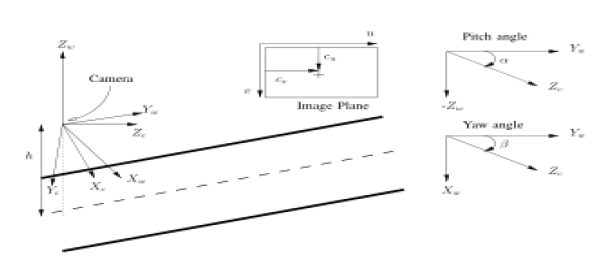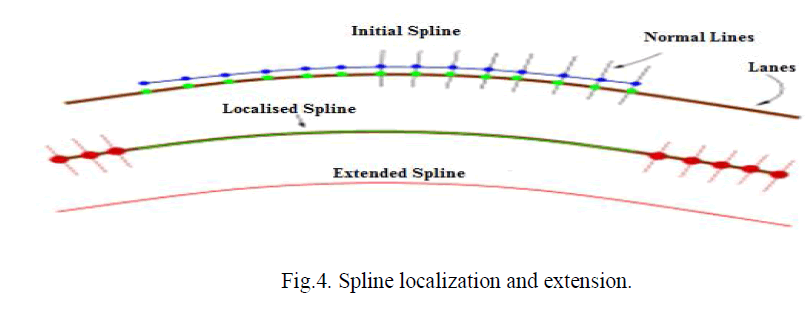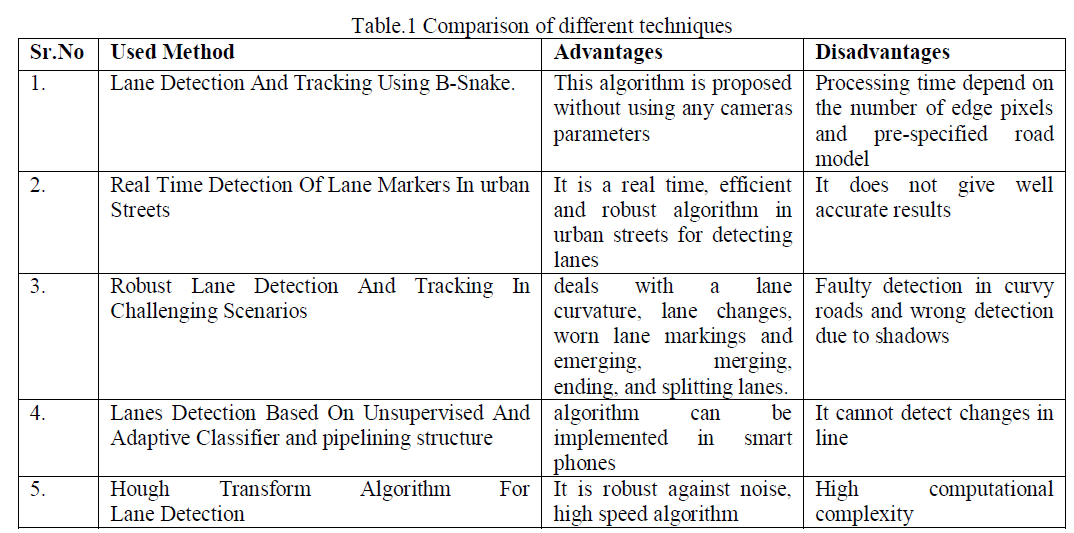ISSN ONLINE(2278-8875) PRINT (2320-3765)
ISSN ONLINE(2278-8875) PRINT (2320-3765)
Sarika Panwar1, Shraddha Raut2
|
| Related article at Pubmed, Scholar Google |
Visit for more related articles at International Journal of Advanced Research in Electrical, Electronics and Instrumentation Engineering
In many highway traffic accidents, the main cause is straight line detection. So as to avoid accidents straight line detection is an important component of intelligent transportation systems. This paper describes different lane marking algorithms and analyses advantages and disadvantages of lane detection algorithms. This paper illustrates the survey of B-Snake algorithm, RANSAC algorithm for urban streets, unsupervised and adaptive classifier technique, robust and lane detection algorithm in challenging scenarios .The most effective technique for straight line detection with reduced logic area and memory utilization is hough transform. The comparative study shows that hough transform based lane detection algorithm is very reliable.
Keywords |
| Hough transforms, straight lane detection, line detection algorithms |
INTRODUCTION |
| The straight line detection has been widely used in many industrial applications like intelligent vehicles, image analysis, pattern recognitions and smart robots. Road traffic accident is one of the problems that are risking people lives. Many lane departure accidents especially on high-way roads are due to driver’s inattention or incompetence or drowsiness. Therefore a system is needed to save the considerable number of lives by warning the driver of imminent danger. Detecting and localizing lanes from a road image is an important component of many intelligent transportation systems. In fact lane detection is one of the most studied topics for intelligent transportation systems within the present decade[1]. Optimal straight line detection is a considerable step for several embedded vision applications. In this paper various line detection algorithms are given. |
| Now a day’s we observe that most researchers focused on increasing need for traffic safety systems to reduce the risk of accidents. The most of the vision based systems for vehicle control, lane departure warning and collision avoidance have been developed during the last two decades. Recently, many Driver Assistance systems (DAS) are emerging to work in harmony with human drivers, e.g. Forward Collision Warning System (FCWS) and on-board Lane Departure Warning System (LDWS). Such systems can be used to help preventing driver’s mistakes and reduce traffic accidents effectively. Recently modern cars are being equipped with a highly sophisticated computerized assist system such as LDWS for safe driving. LDWS is a mechanism designed to warn a driver when the vehicle begins to move out of its lane on roads without a turn signal. The aim of Intelligent Driving Assistance System is mainly that of increasing driving safety and reducing Drivers workload. There are two main types of systems:1. Systems which warn the driver and automatically takes steps to ensure the vehicle stays in its lane (lane keeping system, LKS). 2. Systems which warn the driver (lane departure warning, LDW) if the vehicle is leaving its lane (visual, audible, and/or vibration warnings). LDWS consists of many image processing algorithms, and the lane detection is the most important part of the LDWS. There are several approaches for the lane detection algorithm, such as B-snake, Histogram based segmentation, Edge linking and Hough transform. |
| The paper is organized as follows: Section I gives an Introduction to the Hough Transform, Section II describes different lane detection algorithms and section III gives the comparison of the reviewed papers. The conclusions are drawn in Section IV. |
II. SURVEY OF LANE DETECTION ALGORITHMS |
| Optimal straight line detection is a considerable step for several embedded vision applications, and now the largest research focus is based on the Hough Transform (HT). The straight line detection has been widely used in many industrial applications like image analysis, smart robots, intelligent vehicles, and pattern recognitions. Now a day’s we observe that most researchers focused on increasing need for traffic safety systems to reduce the risk of accidents. There are large numbers of vision based systems for vehicle control, collision avoidance and lane departure warning, which have been developed during the last two decades. Recently, many Driver Assistance systems (DAS) are emerging to work in harmony with human drivers, e.g. Forward Collision Warning System (FCWS) and on-board Lane Departure Warning System (LDWS). Such systems can be used to help preventing driver’s mistakes and reduce traffic accidents effectively [3]. |
| Recently modern cars are being equipped with a highly sophisticated computerized assist system such as LDWS for safe driving. LDWS is a mechanism designed to warn a driver when the vehicle begins to move out of its lane on roads without a turn signal. The aim of Intelligent Driving Assistance System is mainly that of increasing driving safety and reducing Drivers workload. This system can assist drivers to maintain proper driving within the lane and also warn to driver when vehicle is departing from current lane so that driver is alerted to take appropriate action. Lane departure warning system monitors the position of vehicle with respect to boundary. When the vehicle is in danger of leaving the lane unintentionally, for example, when the driver not paying full attention to the road ahead, the system delivers the warning to driver. |
| Many researchers have worked on lane detection algorithm techniques. Various methods for lane detection algorithm are conferred as follow. |
| 1) Y. Wang, E. K. Teoh, and D. Shen introduced lane detection and tracking using b-snake [5]. Here lane detection and tracking is proposed without using any cameras parameters. B-Spline can form any arbitrary shape by a set of control points so the B-Snake based lane model is able to describe a wider range of lane structures. By using the knowledge of the perspective parallel lines the problems of detecting both sides of lane markings (or boundaries) have been merged here as the problem of detecting the mid-line of the lane. For providing a good initial position for the B-Snake, a robust algorithm called CHEVP is proposed. Also to determine the control points of the B-Snake model, a minimum error method by Minimum Mean Square Error (MMSE) is proposed by the overall image forces on two sides of lane. This method is robust against noise, shadows, and illumination variations in the captured road images. It is applicable to the dash and the solid paint line roads also to the marked and the unmarked roads. |
 |
| Lane model plays an important role in lane detection. Here construction of the 2D lane model is done by assuming that the two sides of the road boundaries are parallel on the ground plane as shown in Fig. 1 (a). |
| It is assumed that the right side of road is the shifted version of the left side of road at a distance, D = ( Xr – Xl); along the x axis in the ground plane. Here Xr and Xl is the x coordinates of the two correspondence points P1(X1, y) and Pr(Xr, y) in the ground plane. After projection from ground planes the horizontal distance is given by, |
 |
| where l is the focal length of the lens, H is the height of the camera location, hz is the position of vanishline in the image pane, and r is the vertical coordinate used in the image plane ( as shown in fig. 1 (b)). |
| 2) M. Aly introduced a Real time detection of lane markers in urban streets. It is a real time, efficient and robust algorithm in urban streets for detecting lanes. In this algorithm a top view of the road is generated and then it is filtered using selective which is concerned with Gaussian filters, using RANSAC fitting technique to give initial guesses to a new and its fast RANSAC algorithm for fitting Bezier Splines. Post-processing is the last step. It detects all lanes of the street in still images in different weather conditions. It works at the rate of 50Hz. It gives excellent results in clear condition, but there are some false positives because of stop lines at cross streets, at cross walks, near passing cars. |
| In this algorithm there is a work on the red channel, which gives better images for white and yellow lanes than converting it to gray scale. There should be work done further to improve this algorithm. The further work can be done to classify different lane boundaries by using the color information i.e. white solid lines, double yellow lines etc. This can remove the false positives due to curbs which are detected as lanes, as well as confusing writings on the streets. The drawback of this algorithm for is it does not give well accurate results lane detection [3]. |
 |
| Fig.2. IPM coordinates. Left: the coordinate axes (world, camera, and image frames). Right: definition of pitch α and yaw β angles. |
| In above fig. 2. defination of –a world frame {Fw} = {Xw, Yw, Zw} centred at the camera optical centre, a camera frame {Fc} = {Xc, Yc, Zc}, and an image frame {Fi} = {u,v} are shown. |
 |
| In RANASC it computes the score (measure of goodness) of the spline by rasterizing it using an efficient iterative way and then counting the values of pixels belonging to the spline. It also takes into account the straightness and length of the spline, by penalizing shorter and more curved splines. In above fig. 3, the score is computed as: |
| score = s (1 + k1 l′+ k2 θ′) |
 |
| The post-process is the final step of the algorithm. Here the output of the previous stage tried to better localize the spline and extend it in the image, fig. 4. This is done both in the original image and IPM image. It is done after back projecting the splines from the IPM space to the image space. It is done in localization, extension and geometric cheque steps. After improving the spline’s position, to give an even better fit of the lane an extension in the IPM and original images is performed in order. This is done similarly by looking both forward and backward from the spline end points along the tangent direction (red points), and creating line segments through the normal direction (red line segments), and finding the peak of convolving the gray scale profile of these segments with the smoothing Gaussian filter. |
| 3) Zu Andrés F. Cela , Luis M. Bergasa, Franklin L. Sánchez and Marco A. Herrera introduced Lanes Detection Based on Unsupervised and Adaptive Classifier. This classifier is selected because we do not know the parameters of lanes in the road, although we know that lanes are there, only they need to be classified. The brightness of the lanes of the road in many videos is tested and measured. Generally, the lines on the road are white. They used the HSV image. Then, to yield a set of possible lines they used a Hough transform. These lines have to be classified. With the help of initial parameters the classifier starts because they suppose that the vehicle is on road and in the centre of the lane. The classes are of two types, the first one is the left road line and the second one is the right road line. Also each line has two parameters that are: the line slope and the middle point of line. These parameters are changing in order to adjust to the real lanes. A variable quantity holds the two lines to not to separate more than the variable allows. The new class’s parameters are improved by a Kalman filter estimates and improves the tracking of the lanes. At last they use a mask in order to highlight the lane and show to the user a better image. |
| The algorithm architecture is done in three phases. In Phase 1 we make a previous treatment of the input image. We measure the image brightness, then we define a ROI, and finally the new image is filtered to detect the lanes road in a binary image. In Phase 2 a Hough transform is applied to the image. The result lines are classified by an unsupervised classifier. At last a Kalman filter reduces the noise in the parameters of the lines of each class. These lines are showed in the original image and they built the road. The position of vehicle is estimated in the last phase and the real lanes of the road are highlighted. An indicator shows the driver the deviation on the screen. This algorithm can be implemented in smart phones. The drawback of this system is that it cannot detect changes in line[2]. |
| 4) Zu Whan Kim, proposed a Robust Lane Detection and Tracking in Challenging Scenarios. A robust lane-detectionand- tracking algorithm deals with the challenging scenarios such as a lane curvature, lane changes, worn lane markings and emerging, merging, ending, and splitting lanes. In this algorithm a comparative study is done first to find a good real-time lane marking classifiers and then detection is done. The lane markings are grouped into lane-boundary hypotheses. To handle merging and splitting of lanes, the grouping of left and right lane boundaries is done. |
| A fast and robust algorithm is proposed based on random-sample consensus and particle filtering to generate a large number of hypotheses in real time. This framework explicitly combines a likelihood-based object-recognition algorithm with a Markov-style process (tracking). It can also be applied to general-part-based object tracking problems. An experimental result shows that this algorithm is very reliable on local streets and highways. The disadvantages of this system are there is faulty detection in curvy roads and wrong detection due to shadows [4]. |
| 5) Hyo-Kyun Jeong, Yong-Jin Jeong, and Yi-Fan Lin proposed a design of Hough transform hardware accelerator for Lane detection. Hough transform has robustness against noise. The aim of the Hough transform is to represent geometric forms of the edge information using a parameter space defined by ρ and Ãâè, where ρ is a distance from the origin to the straight-line and Ãâè is the angle between the normal and the X-axis. It maps a geometric line in the image space into a single point in the Hough space. Likewise, inverse Hough transform converts back the point in the Hough space into a line in the image space. In general, the Hough transform is considered to include inverse transform also. |
| Detail procedure of the Hough transform is as follows, first find all of the edge points in image and then compute the ρ using Equation for ρ and Ãâè .Then the computed ρ is used as an address of the accumulator memory for the point where the vote is to be accumulated, after that find local maxima in the Hough space. Finally each local maxima point in Hough space is mapped back to the line in the image space. |
| This method obtains high performance in terms of both execution speed and processing. This algorithm has advantage of reduced logic area and memory utilization. This system can be efficiently designed and simulated with FPGA [1]. |
III. COMPARISON OF LANE DETECTION ALGORITHMS |
| Comparisons of above described papers are given in following Table 1. |
 |
IV.CONCLUSION |
| Lane detection is important because it is an integral part of autonomous vehicle control system. A survey of existing methods for detection and marking of lanes is provided in this work. The previous methods proposed for detection and marking have several shortcomings. A lane departure warning system and lane marking detection using Hough Transform has been proposed. By incorporating a departure warning system, the functionalities of the lane marking system can be enhanced. Hough transform can be implemented on FPGA board. FPGA implementation comsumes less power also it is very compact and fast. |
References |
|